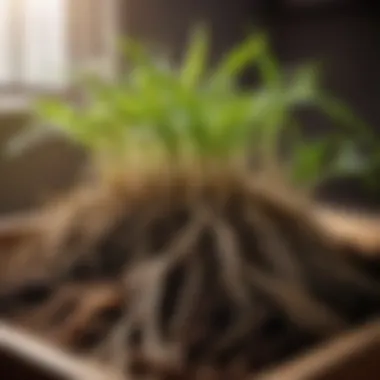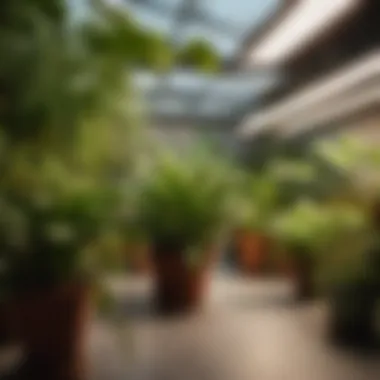The Ultimate Guide to Thriving Indoor Plants: A Comprehensive Approach to Plant Care


Materials:
- Proper size and type of plant pots (preferably with drainage holes). Ensure pots are clean and free of any residues.
- High-quality potting soil mix, rich in nutrients and suitable for indoor plants.
- Fertilizer suitable for indoor plants - organic or synthetic based on personal preference.
- Watering can with a narrow spout for precise watering.
- Pruning shears for trimming and maintaining plant health.
- Plant lighting fixtures - natural light or grow lights based on indoor conditions.
Detailed Instructions:
- Select pots based on the plant's size as well as the room for its root system to grow. Fill the pot with soil, leaving enough space for the plant.
- Choose a quality potting mix with appropriate drainage properties to prevent waterlogging.
- Fertilize the plants as per the instructions on the product, considering the specific needs of each plant type.
- Water the plants when the top inch of soil is dry, ensuring even moisture distribution.
- Regularly prune the plants to promote growth and shape them accordingly.
- Place plants in areas with adequate natural light or supplement with grow lights for optimal growth.
Technical Aspects:
- Timing: Plan repotting and fertilizing based on each plant's growth cycle and seasonal requirements.
- Tools: Ensure clean and sharp pruning shears to prevent damage to the plants.
- Critical Techniques: Learn about pruning for different plant varieties and the significance of correct watering techniques.
Sequential Steps:
- Prepare the pot with soil, ensuring proper drainage.
- Gently remove the plant from its current pot, loosen the roots, and place it in the new pot.
- Fill in additional soil and press lightly to secure the plant while avoiding compacting the soil too much.
- Water the plant thoroughly and place it in its designated spot with adequate lighting.
Troubleshooting Tips:
- Overwatering: Allow the soil to dry out slightly before watering again.
- Yellowing leaves: Check for pest infestations and adjust lighting conditions if necessary.
Conclusion:
By following these meticulous instructions and embracing the technical aspects of indoor plant care, you can create a flourishing indoor oasis that adds vibrancy and freshness to your living space. Stay attentive to your plants' needs and enjoy the beauty and benefits of a well-cared-for indoor garden.
Introduction
In the realm of indoor plant care, the Introduction serves as the gateway to discovering the intricate world of nurturing plants within the confines of your home. By delving into this aspect, you embark on a journey towards creating an indoor oasis that not only survives but thrives, elevating your living space and well-being.
Importance of Introduction
The Introduction sets the foundation for understanding the fundamentals of indoor plant care, offering insights into the crucial elements required to cultivate a thriving botanical sanctuary. It lays the groundwork for novice plant enthusiasts, providing a roadmap that traverses various aspects essential for the health and vitality of indoor plants.
Specific Elements
Within the context of this article, the Introduction elucidates the significance of light, water, soil, humidity, repotting, pest control, pruning, and fertilization in nurturing indoor plants. Each of these elements plays a pivotal role in the well-being of plants, contributing to their growth, vitality, and resilience in indoor environments.
Benefits
By grasping the intricacies outlined in the Introduction, readers can equip themselves with the knowledge necessary to foster a conducive environment for their indoor plants. Understanding these core principles translates into healthier, happier plants that not only survive but thrive, enhancing the aesthetic appeal and ambiance of indoor spaces.


Considerations about Introduction
When delving into the Introduction, it is imperative to consider the individual needs of different plant species, as their requirements vary in terms of light exposure, watering frequency, soil composition, and overall care regimen. Additionally, factors such as indoor climate conditions, seasonal variations, and maintenance routines should be taken into account to ensure the longevity and vibrancy of indoor plants.
Taking a comprehensive approach to plant care starting from the Introduction lays a solid groundwork for navigating the intricate world of indoor gardening, fostering a connection with nature within the confines of your home.
Understanding Light Requirements
In the pursuit of creating the ultimate guide to thriving indoor plants, understanding light requirements takes center stage. Light is a fundamental factor that directly impacts the growth and overall well-being of indoor plants. By grasping the nuances of light requirements, plant enthusiasts can provide their green companions with the optimal conditions for flourishing.
When it comes to indoor plants, assessing light conditions in your home is a critical first step. By gauging the amount and intensity of light available in different areas of your home, you can strategically place plants according to their specific light needs. This subsection delves into two key aspects of assessing light conditions: using a light meter and identifying natural light sources.
Assessing Light Conditions in Your Home
Using a Light Meter
Utilizing a light meter allows you to quantitatively measure the light intensity in various spots around your home. This device provides accurate readings that help you determine if a specific area receives sufficient light for your plants' requirements. By embracing technology to assess light levels, you can make informed decisions when placing different plant species according to their light preferences.
One significant advantage of using a light meter is its precision. Unlike relying solely on visual cues, a light meter offers precise data that eliminates guesswork. This precision is invaluable, especially for light-sensitive plants that require specific light levels to thrive. However, it's essential to note that light meters may vary in their functionalities and accuracy, so selecting a reliable model is paramount for accurate readings.
Identifying Natural Light Sources
Recognizing natural light sources within your home is crucial for optimizing plant placement. Different orientations, such as south-facing windows that receive ample sunlight or north-facing windows with indirect light, offer varying light intensities. Understanding these natural light patterns enables you to strategically position light-loving plants in suitable spots while accommodating shade-tolerant species in lower light zones.
One notable advantage of identifying natural light sources is the cost-effective approach it provides. By harnessing available natural light, you can minimize the need for artificial lighting solutions, saving on energy consumption. However, natural light sources also pose challenges such as varying light exposure throughout the day, necessitating periodic adjustments in plant placement to ensure consistent light access.
Effective Watering Practices
Watering is a crucial aspect of indoor plant care, playing a significant role in the health and vitality of your plants. In this comprehensive guide to thriving indoor plants, a meticulous approach to watering practices is key to ensuring your plant babies flourish to their full potential. Understanding the specific watering needs of each plant type is essential to prevent overwatering or underwatering, which can lead to root rot or dehydration. By mastering effective watering techniques, you lay the groundwork for a thriving indoor oasis.
Determining Watering Needs of Different Plants
Checking Soil Moisture Levels
Checking soil moisture levels is a fundamental skill that every plant parent should possess. By assessing the moisture content of the soil, you can determine when it's time to water your plants. A simple way to check moisture levels is by inserting your finger into the soil up to the first knuckle. If the soil feels damp, it indicates that watering is not needed yet. Conversely, dry soil signifies a plant that is thirsty and requires hydration. By mastering the art of checking soil moisture levels, you can prevent overwatering, a common culprit in indoor plant care, and ensure that your plants receive water only when necessary.
Understanding Plant-Specific Watering Schedules
Different plants have varying watering requirements based on factors such as species, size, and environment. Understanding plant-specific watering schedules involves tailoring your watering frequency to suit the needs of individual plants. Some plants, like succulents, prefer infrequent watering intervals due to their water-storing capabilities, while tropical plants may require more regular hydration. By customizing your watering approach to align with each plant's unique needs, you optimize growth and reduce the risk of root problems associated with incorrect watering practices. Utilizing plant-specific watering schedules is a proactive way to ensure that your indoor plants receive the precise amount of water they need to thrive without any excess that could harm their root systems.
Optimizing Humidity Levels
In the world of indoor plant care, optimizing humidity levels plays a crucial role in ensuring the health and well-being of your green companions. Humidity, the amount of moisture in the air, is essential for plants to thrive, especially in indoor environments where humidity levels may fluctuate. This section will delve into the specific elements, benefits, and considerations of optimizing humidity levels to transform your indoor space into a thriving botanical haven.
Maintaining Ideal Humidity for Indoor Plants
Maintaining ideal humidity for indoor plants is paramount in nurturing their growth and vitality. Two key practices contribute significantly to achieving this goal: using humidifiers and grouping plants with similar humidity needs.
Using Humidifiers:
When it comes to indoor plants, achieving the optimal humidity level can be challenging, particularly in environments with dry air. Using humidifiers is a game-changer in maintaining consistent and adequate moisture levels for your plants. One key characteristic of using humidifiers is their ability to release fine mist or steam into the air, creating a more humid microclimate around your plants. This process is highly beneficial as it mimics the natural conditions of tropical regions, where many houseplants originate, promoting healthy growth and preventing issues like leaf browning or curling due to moisture deficiency. The unique feature of using humidifiers lies in their versatility, as they come in various sizes and designs to suit different plant setups. While the primary advantage of using humidifiers is evident in improving plant health and combating dry air, one potential disadvantage could be excessive moisture accumulation if not monitored carefully.


Grouping Plants with Similar Humidity Needs:
Another effective strategy in maintaining ideal humidity for indoor plants is grouping them based on their humidity requirements. By clustering plants with similar moisture preferences together, you can create microenvironments that cater to their specific needs. This approach optimizes humidity levels by creating pockets of slightly higher moisture around the grouped plants. The key characteristic of grouping plants with similar humidity needs is its ability to streamline care routines, ensuring that plants sharing comparable environmental preferences receive consistent attention. This method is popular among houseplant enthusiasts for its practicality and efficiency in providing targeted care. Additionally, this practice promotes a visually cohesive and aesthetically pleasing display of plants with compatible care requirements. While the advantages of grouping plants based on humidity needs are manifold, it's essential to be cautious of potential disadvantages related to disease spread if proper spacing and ventilation are not maintained.
Nutrient-Rich Soil
In the realm of indoor plant care, the significance of nutrient-rich soil cannot be overstated. Nutrient-rich soil acts as the foundation for plant health and growth, providing essential minerals and elements that facilitate plant development. This section of the guide delves into the critical role that soil plays in fostering flourishing indoor plants.
Choosing the Right Soil Mix for Your Plants
Understanding Soil p
H Levels
Understanding the pH levels of soil is a crucial aspect of plant care as it directly impacts nutrient availability to plants. Different plants thrive in varying pH environments, making it essential to match the soil pH with the specific plant requirements. By comprehending soil pH levels, indoor gardeners can create an optimal growth environment for their plants. The key characteristic of understanding soil pH levels lies in its ability to fine-tune the soil composition to meet the precise needs of different plant species. This tailored approach ensures that plants receive the necessary nutrients for healthy development. While advantageous for the diversity of plant species commonly found indoors, it requires careful monitoring to maintain the ideal pH balance.
Adding Organic Matter for Nutrient Boost
Introducing organic matter into the soil mix serves as a nutrient booster for indoor plants, enhancing their growth and vigor. Organic matter enriches the soil with essential minerals and encourages beneficial microbial activity, fostering a thriving soil ecosystem. The key characteristic of adding organic matter is its natural and sustainable approach to enhancing soil fertility and plant health. This method is popular among indoor gardeners seeking to cultivate a more sustainable and environmentally friendly indoor garden. An advantage of incorporating organic matter is the long-term benefits it provides to plants, promoting robust growth and resilience. However, it requires a balance to prevent over-fertilization and nutrient imbalances, demonstrating the importance of moderation in soil enhancements for indoor plants.
Repotting and Root Care
Repotting and root care play a crucial role in the overall health and growth of indoor plants. As plants grow, their roots require sufficient space and nutrients to thrive, making repotting an essential practice in plant care. By understanding the indications for repotting and addressing root care diligently, you can ensure your plants reach their full potential.
Indications for Repotting
Root-Bound Plants
Root-bound plants refer to plants whose roots have outgrown their current container, causing them to become tightly packed and circling the pot. This results in restricted nutrient absorption and stunted growth. In the context of this article, discussing root-bound plants is vital as it helps readers identify the specific signs indicating the need for repotting.
Root-bound plants exhibit key characteristics such as roots wrapping tightly around each other or the container, excessive root growth compared to foliage, and recurrent wilting despite regular watering. These features signal that the plant has exhausted its current space and requires repotting to continue thriving. While the notion of having roots bound may seem counterintuitive, for certain plant species, it signifies successful growth as the compact roots enable efficient nutrient uptake and water absorption in a confined setting.
Though root-bound plants may seem visually striking, their advantages are often short-lived, emphasizing the necessity of addressing this issue proactively. While allowing for compact root systems, frequent repotting ensures long-term plant health by providing space for sustained growth and nutrient accessibility. Therefore, recognizing and acting upon signs of root-bound conditions is pivotal for maintaining a healthy indoor plant environment.
Soil Depletion Signs
Soil depletion signs refer to the indicators that the soil in a plant's container has been exhausted of essential nutrients, culminating in poor plant health and growth. Soil, over time, loses its nutritional value as plants absorb the available nutrients, necessitating regular soil replenishment. In the context of this article, understanding soil depletion signs is crucial for implementing effective repotting and root care strategies.
Key characteristics of soil depletion include stunted plant growth, yellowing or browning of leaves, soil compacting and drying out quickly, and visible mineral deposits on the soil surface. These signs suggest that the soil has become depleted and requires refreshing to support plant vitality.
By recognizing soil depletion signs promptly, plant owners can prevent nutrient deficiencies and promote optimal plant development. Regularly repotting plants with depleted soil, incorporating nutrient-rich soil mixes, and supplementing with organic matter can rejuvenate the soil's fertility, fostering healthy root growth and overall plant well-being. Addressing soil depletion signs is integral to maintaining a thriving indoor plant ecosystem and ensuring long-term success in plant care.
Pest Prevention and Control
In the realm of indoor plant care, pest prevention and control play a critical role in ensuring the health and vitality of your beloved green companions. Effectively managing pests not only protects your plants from damage but also promotes a thriving indoor environment. By carefully monitoring and addressing potential pest issues, you can safeguard your plants and maintain their beauty.
Identifying Common Plant Pests
Spider Mites
Spider mites are minuscule pests that can wreak havoc on your indoor plants if left unchecked. These tiny arachnids are known for their webbing production, which they use to colonize leaves and extract nutrients from plant tissues. One of the key characteristics of spider mites is their rapid reproductive rate, allowing infestations to escalate swiftly. Despite their diminutive size, spider mites pose a significant threat to plant health due to their piercing-sucking mouthparts, leading to yellowing, stippling, and ultimately, plant decline. While difficult to spot with the naked eye, their detrimental impact on plant vigor necessitates proactive pest management strategies.


Fungus Gnats
Fungus gnats are another common nuisance for indoor plants, particularly in environments with excess moisture levels. These small, flying insects are attracted to damp soil and decaying organic matter, where they lay eggs that hatch into larvae. The key characteristic of these pests is their association with wet conditions, making overwatered plants especially vulnerable to infestation. Fungus gnat larvae feed on root hairs and organic debris in the soil, potentially impeding nutrient uptake and leading to weakened plant health. Although adult fungus gnats are relatively harmless, their larval stage can cause root damage and hinder plant growth. Implementing proper watering practices and soil management is crucial in preventing and controlling fungus gnat populations in indoor plant settings.
This detailed exploration serves as a valuable resource for understanding and addressing common plant pests like spider mites and fungus gnats, empowering plant enthusiasts to maintain pest-free environments and foster thriving indoor greenery.
Promoting Growth Through Pruning
Pruning is a crucial practice in indoor plant care that plays a significant role in promoting healthy growth and vitality. In this comprehensive guide to thriving indoor plants, the section on Promoting Growth Through Pruning dives deep into the intricate art of trimming and shaping plants to encourage optimal development. By strategically removing certain parts of the plant, you not only enhance its aesthetic appeal but also boost its overall health and vigor. This section emphasizes the importance of regular pruning as a proactive measure to ensure your plants reach their full potential.
Trimming Techniques for Healthy Growth
Removing Dead or Yellowing Leaves
Removing dead or yellowing leaves is a fundamental aspect of plant care aimed at maintaining the plant's vitality and preventing the spread of diseases. This practice involves carefully identifying and selectively trimming off any foliage that shows signs of decline. By eliminating these compromised parts, you redirect the plant's energy towards new growth, ensuring that nutrients are channeled where they are needed most. Additionally, removing dead or yellowing leaves helps enhance the plant's appearance, giving it a rejuvenated and vibrant look. This technique is essential in preventing any potential harm that decaying leaves can cause to the plant's overall well-being.
Encouraging Bushier Growth
Encouraging bushier growth through strategic pruning techniques is vital for creating a lush and full-bodied indoor plant. By selectively trimming certain stems or branches, you prompt the plant to develop multiple shoots, resulting in a denser and more compact growth habit. This not only adds visual appeal to your plant but also stimulates increased flowering or fruiting, depending on the plant species. Encouraging bushier growth also helps maintain the plant's shape and size, preventing it from becoming leggy or sparse over time. While this technique requires precision and care, the benefits of fostering a bushier form far outweigh the initial effort, ultimately leading to a more robust and attractive indoor plant.
Creating a Fertilization Schedule
In the realm of indoor plant care, one crucial aspect that often determines the overall health and growth of your plants is creating a fertilization schedule. This section outlines the significance of a well-structured fertilization schedule in ensuring your indoor plants receive the necessary nutrients to thrive.
A meticulously planned fertilization schedule plays a pivotal role in providing indoor plants with a balanced nutrient intake essential for their growth and development. By adhering to a consistent fertilization plan, you can ensure that your plants receive the right amount of nutrients at the right time, promoting optimal health and vitality. This structured approach not only fosters healthy foliage and blooms but also strengthens the plants' resilience against diseases and environmental stressors.
When crafting a fertilization schedule, consider aspects such as the specific nutrient requirements of different plant species, the growth stage of the plants, and the seasonal variations that can impact their nutrient uptake. By tailoring the fertilization regimen to meet the individual needs of your indoor plants, you can address any deficiencies and maintain nutrient balance for sustained growth.
Balanced Nutrient Intake for Plants
Understanding N-P-K Ratios
Delving into the realm of plant nutrition, understanding the N-P-K ratios is paramount for creating a balanced nutrient intake for your indoor plants. Nitrogen (N), phosphorus (P), and potassium (K) are the three key macronutrients that plants require in varying quantities for essential functions.
N-P-K ratios indicate the percentage of each nutrient present in a fertilizer formulation, guiding you in selecting the appropriate blend to meet your plants' specific needs. For instance, a high nitrogen ratio promotes lush foliage growth, while elevated phosphorus levels enhance root development and flowering, and potassium aids in overall plant vigor and disease resistance.
By comprehending N-P-K ratios and their implications on plant health, you can tailor your fertilization schedule to optimize nutrient uptake, foster robust growth, and fortify your indoor plants against environmental stresses.
Organic vs. Synthetic Fertilizers
The debate between organic and synthetic fertilizers is a critical consideration when establishing a fertilization schedule for indoor plants. Organic fertilizers derive from natural sources such as compost, manure, or plant residues, offering slow-release nutrients that enrich the soil and promote long-term plant health.
On the other hand, synthetic fertilizers are chemically formulated to deliver fast-acting nutrients in precise concentrations, providing readily available nourishment for immediate plant uptake. While organic fertilizers enhance soil structure and microbial activity, synthetic fertilizers offer quick nutrient solutions for targeted plant requirements.
When deciding between organic and synthetic fertilizers, evaluate factors such as nutrient availability, long-term soil sustainability, environmental impact, and plant-specific preferences to determine the most suitable option for your indoor plants. Both types of fertilizers serve distinct purposes, and selecting the appropriate one aligns with your plant care goals and overall cultivation approach.
Conclusion
In the realm of indoor plant care, the conclusion serves as the culmination of a meticulous and dedicated approach to cultivating thriving greenery within your living space. As we journeyed through the various sections of this definitive guide, it becomes evident that the conclusion holds a special significance in encapsulating the essence of our indoor plant care regimen.
The importance of the conclusion lies in its ability to tie together the diverse elements that contribute to the overall health and vitality of indoor plants. It serves as a reminder of the intricacies involved in nurturing these botanical companions and underlines the commitment required to ensure their growth and prosperity.
One of the primary benefits of emphasizing the conclusion within this article is the reinforcement of core principles essential for maintaining indoor plants. By revisiting key concepts such as light requirements, watering practices, humidity optimization, soil nutrition, repotting tips, pest prevention, pruning techniques, and fertilization schedules, readers are encouraged to integrate these factors seamlessly into their plant care routine.
Moreover, the conclusion offers a moment of reflection, enabling housewives and homeowners to appreciate the transformation their living spaces have undergone through the incorporation of indoor plants. It instills a sense of satisfaction and pride in the effort invested in creating a vibrant, green oasis that not only enhances aesthetic appeal but also promotes well-being.
As individuals immerse themselves in the rewarding experience of watching their plants flourish, the conclusion serves as a catalyst for future endeavors in plant care. It motivates readers to explore new species, experiment with innovative techniques, and expand their knowledge to ensure a continuous cycle of growth and rejuvenation within their indoor garden.
In essence, the conclusion of the 'Ultimate Guide to Thriving Indoor Plants' encapsulates the dedication, nurturing spirit, and passion required to cultivate a harmonious coexistence with nature within the confines of your home. It symbolizes a commitment to sustainability, mindfulness, and beauty, making every step of the plant care journey a fulfilling and enriching endeavor.







